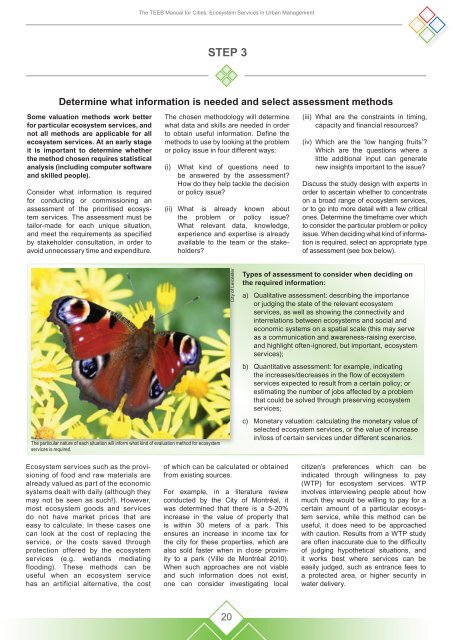TEEB Manual for Cities
TEEB Manual for Cities
TEEB Manual for Cities
Create successful ePaper yourself
Turn your PDF publications into a flip-book with our unique Google optimized e-Paper software.
The <strong>TEEB</strong> <strong>Manual</strong> <strong>for</strong> <strong>Cities</strong>: Ecosystem Services in Urban ManagementStep 3Determine what in<strong>for</strong>mation is needed and select assessment methodsSome valuation methods work better<strong>for</strong> particular ecosystem services, andnot all methods are applicable <strong>for</strong> allecosystem services. At an early stageit is important to determine whetherthe method chosen requires statisticalanalysis (including computer softwareand skilled people).Consider what in<strong>for</strong>mation is required<strong>for</strong> conducting or commissioning anassessment of the prioritised ecosystemservices. The assessment must betailor-made <strong>for</strong> each unique situation,and meet the requirements as specifiedby stakeholder consultation, in order toavoid unnecessary time and expenditure.The chosen methodology will determinewhat data and skills are needed in orderto obtain useful in<strong>for</strong>mation. Define themethods to use by looking at the problemor policy issue in four different ways:(i)What kind of questions need tobe answered by the assessment?How do they help tackle the decisionor policy issue?(ii) What is already known aboutthe problem or policy issue?What relevant data, knowledge,experience and expertise is alreadyavailable to the team or the stakeholders?(iii) What are the constraints in timing,capacity and financial resources?(iv) Which are the ‘low hanging fruits’?Which are the questions where alittle additional input can generatenew insights important to the issue?Discuss the study design with experts inorder to ascertain whether to concentrateon a broad range of ecosystem services,or to go into more detail with a few criticalones. Determine the timeframe over whichto consider the particular problem or policyissue. When deciding what kind of in<strong>for</strong>mationis required, select an appropriate typeof assessment (see box below).The particular nature of each situation will in<strong>for</strong>m what kind of evaluation method <strong>for</strong> ecosystemservices is required.City of LeicesterTypes of assessment to consider when deciding onthe required in<strong>for</strong>mation:a) Qualitative assessment: describing the importanceor judging the state of the relevant ecosystemservices, as well as showing the connectivity andinterrelations between ecosystems and social andeconomic systems on a spatial scale (this may serveas a communication and awareness-raising exercise,and highlight often-ignored, but important, ecosystemservices);b) Quantitative assessment: <strong>for</strong> example, indicatingthe increases/decreases in the flow of ecosystemservices expected to result from a certain policy; orestimating the number of jobs affected by a problemthat could be solved through preserving ecosystemservices;c) Monetary valuation: calculating the monetary value ofselected ecosystem services, or the value of increasein/loss of certain services under different scenarios.Ecosystem services such as the provisioningof food and raw materials arealready valued as part of the economicsystems dealt with daily (although theymay not be seen as such!). However,most ecosystem goods and servicesdo not have market prices that areeasy to calculate. In these cases onecan look at the cost of replacing theservice, or the costs saved throughprotection offered by the ecosystemservices (e.g. wetlands mediatingflooding). These methods can beuseful when an ecosystem servicehas an artificial alternative, the costof which can be calculated or obtainedfrom existing sources.For example, in a literature reviewconducted by the City of Montréal, itwas determined that there is a 5-20%increase in the value of property thatis within 30 meters of a park. Thisensures an increase in income tax <strong>for</strong>the city <strong>for</strong> these properties, which arealso sold faster when in close proximityto a park (Ville de Montréal 2010).When such approaches are not viableand such in<strong>for</strong>mation does not exist,one can consider investigating localcitizen’s preferences which can beindicated through willingness to pay(WTP) <strong>for</strong> ecosystem services. WTPinvolves interviewing people about howmuch they would be willing to pay <strong>for</strong> acertain amount of a particular ecosystemservice, while this method can beuseful, it does need to be approachedwith caution. Results from a WTP studyare often inaccurate due to the difficultyof judging hypothetical situations, andit works best where services can beeasily judged, such as entrance fees toa protected area, or higher security inwater delivery.20
















